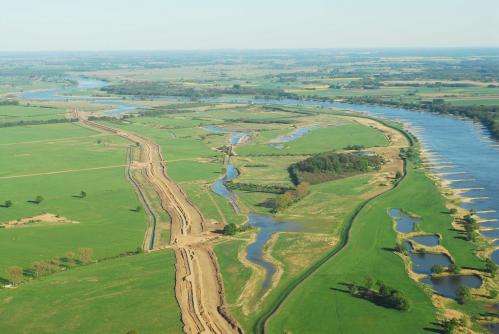Flood: Rerouted levee stands the test

(Phys.org) —A restored floodplain with a high diversity of species and effective flood protection – these are the results of the large-scale nature protection project "Lenzener Elbtalaue". Under the direction of biologist Dr. Christian Damm from KIT, the levee along the Elbe river near Lenzen (Brandenburg) was relocated into the hinterland. This largest levee rerouting project in Germany recently stood the first test: During the Elbe flood this year, the floodplain between the old and the new levee protected the hinterland from being damaged.
The location "Böse Ort" ("bad place") has lost its horror: Near Lenzen in the district of Prignitz/Brandenburg, the Elbe river bends by 90 degrees. For centuries, this bend has been considered a high hydraulic hazard, as the water flow width was further narrowed by levees. During the flood of 2002, the levee had to be protected with an enormous expenditure. Meanwhile, this has changed: A levee section of more than 7.4 km in length along the river was relocated into the hinterland by up to 1.3 km. The new levee is about 6.1 km long. The old levee remained standing, but was opened at six points. Between both levees, a floodplain of about 420 hectares was created. It has a capacity of up to 16 million cubic meters of water. This capacity was exhausted completely by the Elbe flood in early June. The surroundings were not damaged at all. "Lenzener Elbtalaue" has been the largest levee rerouting project in Germany so far.
"The project ideally combines nature protection with flood protection, tourism, and other uses of the floodplain," explains Dr. Christian Damm, WWF Institute for Floodplains Ecology of the KIT Institute of Geography and Geoecology. He managed the levee rerouting project that was completed in 2009. It was aimed at protecting nature and restoring a floodplain with a rich flora and fauna influenced by the alternating rhythm of the river with drought at low tide and flooding at high tide. Hence, the floodplain was connected with the river. On the former pasture, thousands of oak trees, elm trees, and willows were planted, which slow down the flood waves.
The newly created detention space can reduce the water level during extreme floods by up to 40 cm in this section. 75 percent of the project costs were borne by the federation, 18 percent by the State of Brandenburg. The remaining 7 percent were paid by the local protection association Trägerverbund Burg Lenzen e.V. and an alliance of various nature protection associations around BUND (Friends of the Earth Germany). "Of course, this project has a regional impact only," Dr. Christian Damm from KIT says. "It was demonstrated by the recent flood, however, that it is worth restoring the natural functions of the floodplain as a flood detention space. Other projects will have to follow."
Provided by Karlsruhe Institute of Technology





















